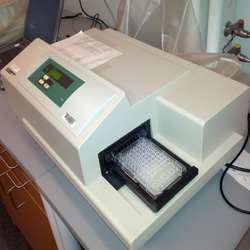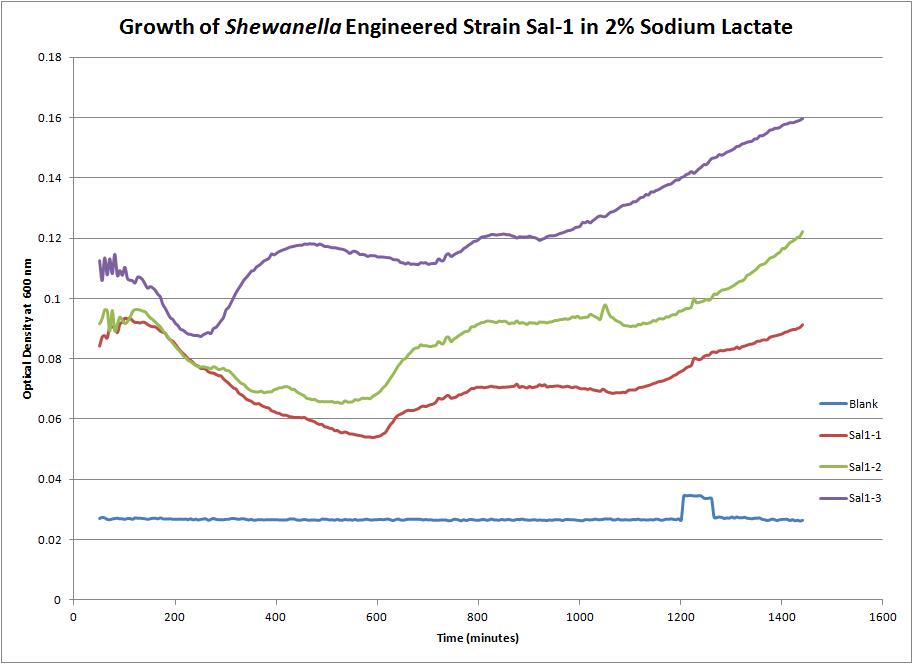Team:Cornell/testing/project/wetlab/4/5
From 2012.igem.org
(Difference between revisions)
| (One intermediate revision not shown) | |||
| Line 33: | Line 33: | ||
Testing & Results | Testing & Results | ||
<ul> | <ul> | ||
| + | <li> | ||
| + | <a href="https://2012.igem.org/Team:Cornell/testing/project/wetlab/4/7">Parts</a> | ||
| + | </li> | ||
<li> | <li> | ||
<a href="https://2012.igem.org/Team:Cornell/testing/project/wetlab/4/1">Reactors</a> | <a href="https://2012.igem.org/Team:Cornell/testing/project/wetlab/4/1">Reactors</a> | ||
| Line 91: | Line 94: | ||
<div class="nine columns"> | <div class="nine columns"> | ||
<h3>Growth Assays</h3> | <h3>Growth Assays</h3> | ||
| - | Various engineered strains were tested with different amounts of sodium lactate in 20 hour or greater growth trials, in synthetic river media. After a few weeks of editing the protocol, a final procedure was developed for the <a href="https://static.igem.org/mediawiki/2012/6/6c/Growth_Assay_Protocol.pdf" target="_blank"><i>Shewanella</i> growth assay</a>. The results of the most successful experiment are shown below, with an OD600 minimum of 0. | + | Various engineered strains were tested with different amounts of sodium lactate in 20 hour or greater growth trials, in synthetic river media. After a few weeks of editing the protocol, a final procedure was developed for the <a href="https://static.igem.org/mediawiki/2012/6/6c/Growth_Assay_Protocol.pdf" target="_blank"><i>Shewanella</i> growth assay</a>. The results of the most successful experiment are shown below, with an OD600 minimum of 0.06 reached for all three samples, with the sample appearing to still be on the rise. Therefore, a steady flow of 2% (w/v) sodium lactate could likely keep the cells alive and functioning for a long period of time in the reactor, though more testing will be needed to completely verify this claim. |
</div> | </div> | ||
</div> | </div> | ||
<div class="twelve columns"> | <div class="twelve columns"> | ||
<img class="inline" src="https://static.igem.org/mediawiki/2012/a/ac/Sal1GrowthCurve.jpg"> | <img class="inline" src="https://static.igem.org/mediawiki/2012/a/ac/Sal1GrowthCurve.jpg"> | ||
| - | <b> Fig. 1. Growth as OD600 over time is plotted for a 96 well-plate inoculated with engineered strain <i>S. oneidensis</i> Sal1 growing on 2% sodium lacate in Synthetic River Media. Three trials of the same strain are shown | + | <b> Fig. 1. Growth as OD600 over time is plotted for a 96 well-plate inoculated with engineered strain <i>S. oneidensis</i> Sal1 growing on 2% sodium lacate in Synthetic River Media. Three trials of the same strain are shown supporting an average OD600 of 0.098 (σ=0.034).</b><br><br> |
</div> | </div> | ||
Latest revision as of 03:22, 4 October 2012
-
Wet Lab
- Overview
- Chassis
- DNA Assembly
- Testing & Results
- Future Work
- Animation
Artificial River Media Growth Assays

Determining Food Tank Parameters
With the intention to make a biosensor capable of working self sufficiently for a long period of time, maintaining the biological elements of the system is crucial. Therefore, assays were performed to determine the parameters of the food tank. Using only sodium lactate as a carbon source for Shewanella, the minimum concentration of nutrients that the bacteria needed to survive would be determined. Considering the device was created with six liters of space for nutrients to be added, what would be the maximum concentration and miniumum flow rate that could be used by the device, to maintain successful results? The first step in this is to simulate river conditions and add different "flow rates" of sodium lactate. Then this determined concentration should be tested for biosensing ability in a later reactor test.Developing Synthetic River Media
The first step is to determine the contents of a river of interest. The Athabasca river was selected, as it is of particular importance in the Oil Sands region of Alberta. The information on various concentrations of ions, water hardness, pH, etc. came from the Oil Sands Information Portal. Based on this information, as well as available salts to use, a recipe for Synthetic River Media was created to match the biologically significant parameters of the river's contents to the solution which would be used for later growth tests.

Growth Assays
Various engineered strains were tested with different amounts of sodium lactate in 20 hour or greater growth trials, in synthetic river media. After a few weeks of editing the protocol, a final procedure was developed for the Shewanella growth assay. The results of the most successful experiment are shown below, with an OD600 minimum of 0.06 reached for all three samples, with the sample appearing to still be on the rise. Therefore, a steady flow of 2% (w/v) sodium lactate could likely keep the cells alive and functioning for a long period of time in the reactor, though more testing will be needed to completely verify this claim. Fig. 1. Growth as OD600 over time is plotted for a 96 well-plate inoculated with engineered strain S. oneidensis Sal1 growing on 2% sodium lacate in Synthetic River Media. Three trials of the same strain are shown supporting an average OD600 of 0.098 (σ=0.034).
Fig. 1. Growth as OD600 over time is plotted for a 96 well-plate inoculated with engineered strain S. oneidensis Sal1 growing on 2% sodium lacate in Synthetic River Media. Three trials of the same strain are shown supporting an average OD600 of 0.098 (σ=0.034). "
"







